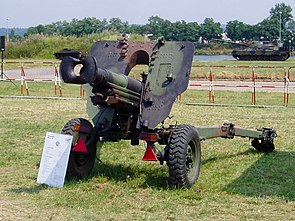Mountain howitzer model 56
| Mountain howitzer model 56 | |
|---|---|
|
|
|
| General Information | |
| Military designation: | GebHaub 105 (Mod. 56) |
| Manufacturer designation: | Mod. 56/14 |
| Manufacturer country: |
|
| Developer / Manufacturer: | Oto Melara |
| Development year: | 1956 |
| Weapon Category: | howitzer |
| Technical specifications | |
| Pipe length: | 1.47 m |
| Caliber : |
105 mm |
| Elevation range: | −7 ° to + 65 ° angular degrees |
| Side straightening area: | 36 ° |
| Furnishing | |
| Closure Type : | vertical slide |
| Charging principle: | hydropneumatic |
The mountain howitzer model 56 is a howitzer with the caliber 105 mm / L 14 from the Italian manufacturer Oto Melara . It uses standardized NATO - ammunition (US-type M1).
history
The Model 56 was developed as a light howitzer in the 1950s to equip the brigades of the Italian mountain troops . Howitzers of this model have been in use there for half a century since they were delivered.
Despite its caliber, the Model 56 mountain howitzer can be carried by its gun group and can also be used for direct aiming . As a mountain howitzer, it can be broken down into twelve assemblies that can be easily transported. Transport on pack animals in a special pack saddle is also planned. The Model 56 is usually pulled by a Jeep or Land Rover, and can even be transported without a shield in an M113 or as an external load on a Bell UH-1D . Otherwise, the mountain howitzer is transported outside the combat area on long distances on trucks.
The mountain howitzer was of great importance for western armies in the 1960s due to its low weight of just over 1.2 tons, which also allowed it to be transported by helicopter . The howitzer was therefore used in the light artillery of many countries and also by special forces such as mountain and airborne troops . In total, the Model 56 was used in around 30 countries around the world.
However, the howitzer's light weight was also a disadvantage. The Australian and New Zealand armed forces criticized their lack of robustness during the Vietnam War and found them unsuitable for lengthy operations. Therefore, after a few years, they were replaced by the US M101 A1 .
The Chinese manufacturer Norinco today offers a version of the Model 56 self-propelled howitzer with ammunition.
In the armies of the Commonwealth , the howitzer was used as an L5 Pack Howitzer with L10 ammunition. However, their short range and the different combat strength of the ammunition moved the British Army two years after commissioning to develop the L118 Light Gun as a replacement for the howitzer .
War missions
The howitzer was used by the Argentine Armed Forces in the 1982 Falklands War . It was also used as the L5 by the Royal Artillery in South Yemen and by British and Australian forces during the Konfrontasi 1963-1966 on Borneo . The Royal Regiment of New Zealand Artillery used the howitzer in the Vietnam War 1965-1967.
armed forces
While the majority of Oto Melara 105 mm mountain howitzers were equipped with the Italian L 14 gun barrel (sometimes referred to as "Model 1958" in sources), the 105 mm mountain howitzers used by the Bundeswehr 's mountain troops were equipped with a new gun barrel German manufacture and a modified muzzle brake .
The name was Gebirgshaubitze 105 (GebHaub 105) . The two mountain artillery battalions 225, set up in Sonthofen in 1962 (later in Füssen), and 235, set up in Bad Reichenhall in 1959 from the previous 8th / Mountain Artillery Regiment, were equipped with the mountain howitzer. The air-loadable version without a shield was used by the 9 AMF airborne artillery battery .
Initially the Unimog U 1.5t gl (1.5 tonner) was used as the tractor , later the Unimog U 2t gl and the Husky .
Trivia
On July 31, 1967, the 2nd Battery of Mountain Artillery Battalion 235, as part of a combat exercise, brought a mountain howitzer 105 mm into position on the Watzmann , Hocheck at an altitude of 2624 m. The first 1000 meters were transported with two groups of pack animals in half a day. For the remaining 700 meters in altitude, the twelve loads, each weighing 120 kg, were loaded onto sledges and brought up to the firing position using pull ropes in the team platoon within two days .
Current users
Previous users
Web links
Individual evidence
- ^ Ian Hogg : Twentieth Century Artillery . Grange Press, Hoo 2002, ISBN 1-84013-315-5
- ↑ Christopher F. Foss : China expands tube artillery capability . In: Jane's International Defense Review , Vol. 42 (2009), May, ISSN 0020-6512 .
- ^ Chronicle of the 1st Mountain Division, RMS-Verlag, Wolfsheim 1994
- ^ Fahnenjunker Reiser, article in Chronik der 1. Gebirgsdivision, RMS-Verlag, Wolfsheim 1994
- ↑ Poppe, Michael, Das Heer 1950–1970 conception, organization and installation, Oldenbourg Verlag, Munich 2006, p. 303



